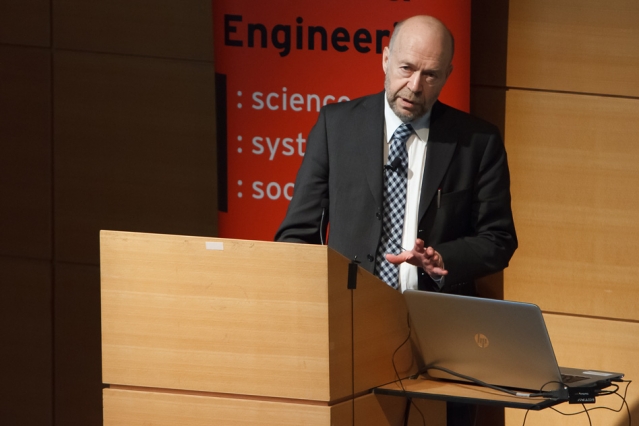Hansen came to prominence in the late 1980s, when he first testified before Congress about the perils of accumulating carbon dioxide in the atmosphere.
“I think it’s really important that young people understand the situation that we older people are leaving them with,” said Hansen, currently an adjunct professor at Columbia University’s Earth Institute. “It’s going to be extraordinarily difficult to deal with … and I’ve become frustrated with governments that don’t recognize their responsibilities to future generations.”

James Hansen delivers the 13th annual David Rose Lecture at MIT’s Wong Auditorium. Photo: Russ Campbell
“We have an emergency,” Hansen said. He pointed out that there is a lag in the climate system, so the planet has not yet finished warming from the greenhouse gases that are already in the atmosphere. “And we’re adding more all the time,” he added.
What’s more, the response to this increase in greenhouse gases is likely to be extremely nonlinear, he said: “It just turns out that our climate system is dominated by amplifying feedbacks … so there’s a danger that the system is going to run out of control.”
Some effects of climate change, he said, are simply irreversible. For example, the Intergovernmental Panel on Climate Change has projected that 25 to 50 percent of all species on Earth could be extinct by 2100 if energy use continues on its current trajectory. The loss of ice sheets is essentially also irreversible, since it takes thousands of years for these sheets to accumulate. While most policy recommendations have focused on trying to limit greenhouse gas emissions to a level that would produce warming of no more than 2 degrees Celsius, that is “actually a disaster scenario, in my opinion,” Hansen said: It would likely cause so much melting of ice sheets that the resulting sea-level rise would render most of the world’s coastal cities uninhabitable.
Rebalancing the system
“We have to rebalance the planet’s energy balance,” Hansen said. Earlier calculations, he said, had indicated that would require a sustained reduction of 6 percent annually in global carbon emissions — a very difficult target to meet — but more recent measurements have shown that the planet is absorbing more carbon dioxide than scientists had expected, so the actual needed reduction may be less.
“We need to be realistic in looking at the available energy sources,” he said, pointing out that solar and wind energy still represent only about 3 percent of global energy supply. “If we could decarbonize electricity, then we could solve the problem. "
Even liquid fuels for transportation can be manufactured using alternative sources of electricity. Sweden, he noted, has already achieved essentially carbon-free electricity, thanks to a combination of nuclear power and abundant hydropower; France is nearing this goal, thanks mostly to its extensive use of nuclear power. Both countries, he said, produced most of their nuclear infrastructure within a decade, “so that has been the fastest way to decarbonize that has been demonstrated so far.”
“I think you need to be open-minded. We should be looking at all the carbon-free energy sources, and figuring out what their contribution should be — and frankly, the market should be helping us do it. … We should have a carbon-free energy portfolio, and let the market find what is the least expensive way. We should be doing [research and development] on all the good candidates, and certainly nuclear is one of them.”





Comments